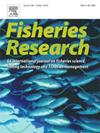Identifying the spatio-temporal distribution patterns of mixed fisheries to inform multispecies management in the Yellow and Bohai Seas
IF 2.2
2区 农林科学
Q2 FISHERIES
引用次数: 0
Abstract
Mixed fisheries contribute to a substantial proportion of global landings and pose great challenges to fisheries management. In order to construct the management scheme for multiple species simultaneously, the species co-occurrence needs to be explicitly delineated in mixed fisheries. However, the task is hindered by the lack of survey coverage and the constraints of common species distribution models in ignoring biotic interactions. In the present study, we investigated the spatio-temporal distribution patterns of mixed fisheries over large spatial and temporal scales, by implementing the Vector Autoregressive Spatio-Temporal model (VAST) on the basis of fishery-dependent data collected from fishing logs. The fishery-dependent surveys were conducted among the commercial fishing vessels operating in the Yellow and Bohai Seas from 2012 to 2022. We used the VAST to handle the problem of unbalanced sampling, inflated zeros and interspecific interactions, and divided the species into species complexes with clustering analyses according to their correlation in the spatial or spatio-temporal distributions. Our results indicated that the studied species in mixed fisheries could be divided into three species complexes, and the composition within each group depended on consideration of spatial or spatio-temporal correlations. We demonstrated significant differences in the spatial distribution and aggregation areas among the species complexes, and substantial seasonal variations in occurrence of spatio-temporal complexes, which should be informative for the assignment of management unit within the mixed fisheries. Our study demonstrated the approach to assessing the species co-occurrence of mixed fisheries using fishery-dependent data, which offers the opportunity for guiding the future management of mixed fisheries.
黄渤海混合渔业时空分布格局研究为多物种管理提供依据
混合渔业占全球渔获量的很大一部分,并对渔业管理构成巨大挑战。为了构建多鱼种同时存在的管理方案,需要对混合渔业中鱼种共现进行明确的圈定。然而,由于缺乏调查覆盖和常见物种分布模型的限制,忽略了生物相互作用,阻碍了这项任务的完成。本文以渔业相关数据为基础,采用向量自回归时空模型(VAST)研究了大时空尺度上混合渔业的时空分布格局。渔业相关调查是对2012 - 2022年在黄渤海海域作业的商业渔船进行的。利用VAST处理采样不平衡、虚零和种间相互作用等问题,并根据物种在空间或时空分布上的相关性将物种划分为物种复合体并进行聚类分析。研究结果表明,混合渔场的物种可划分为3个物种复合体,每个复合体内的组成取决于空间或时空相关性。研究结果表明,各物种复合体的空间分布和聚集区域存在显著差异,时空复合体的发生也存在明显的季节变化,这为混合渔业管理单位的分配提供了参考。我们的研究展示了利用渔业依赖数据评估混合渔业物种共生的方法,为指导未来混合渔业的管理提供了机会。
本文章由计算机程序翻译,如有差异,请以英文原文为准。
求助全文
约1分钟内获得全文
求助全文
来源期刊

Fisheries Research
农林科学-渔业
CiteScore
4.50
自引率
16.70%
发文量
294
审稿时长
15 weeks
期刊介绍:
This journal provides an international forum for the publication of papers in the areas of fisheries science, fishing technology, fisheries management and relevant socio-economics. The scope covers fisheries in salt, brackish and freshwater systems, and all aspects of associated ecology, environmental aspects of fisheries, and economics. Both theoretical and practical papers are acceptable, including laboratory and field experimental studies relevant to fisheries. Papers on the conservation of exploitable living resources are welcome. Review and Viewpoint articles are also published. As the specified areas inevitably impinge on and interrelate with each other, the approach of the journal is multidisciplinary, and authors are encouraged to emphasise the relevance of their own work to that of other disciplines. The journal is intended for fisheries scientists, biological oceanographers, gear technologists, economists, managers, administrators, policy makers and legislators.
 求助内容:
求助内容: 应助结果提醒方式:
应助结果提醒方式:


